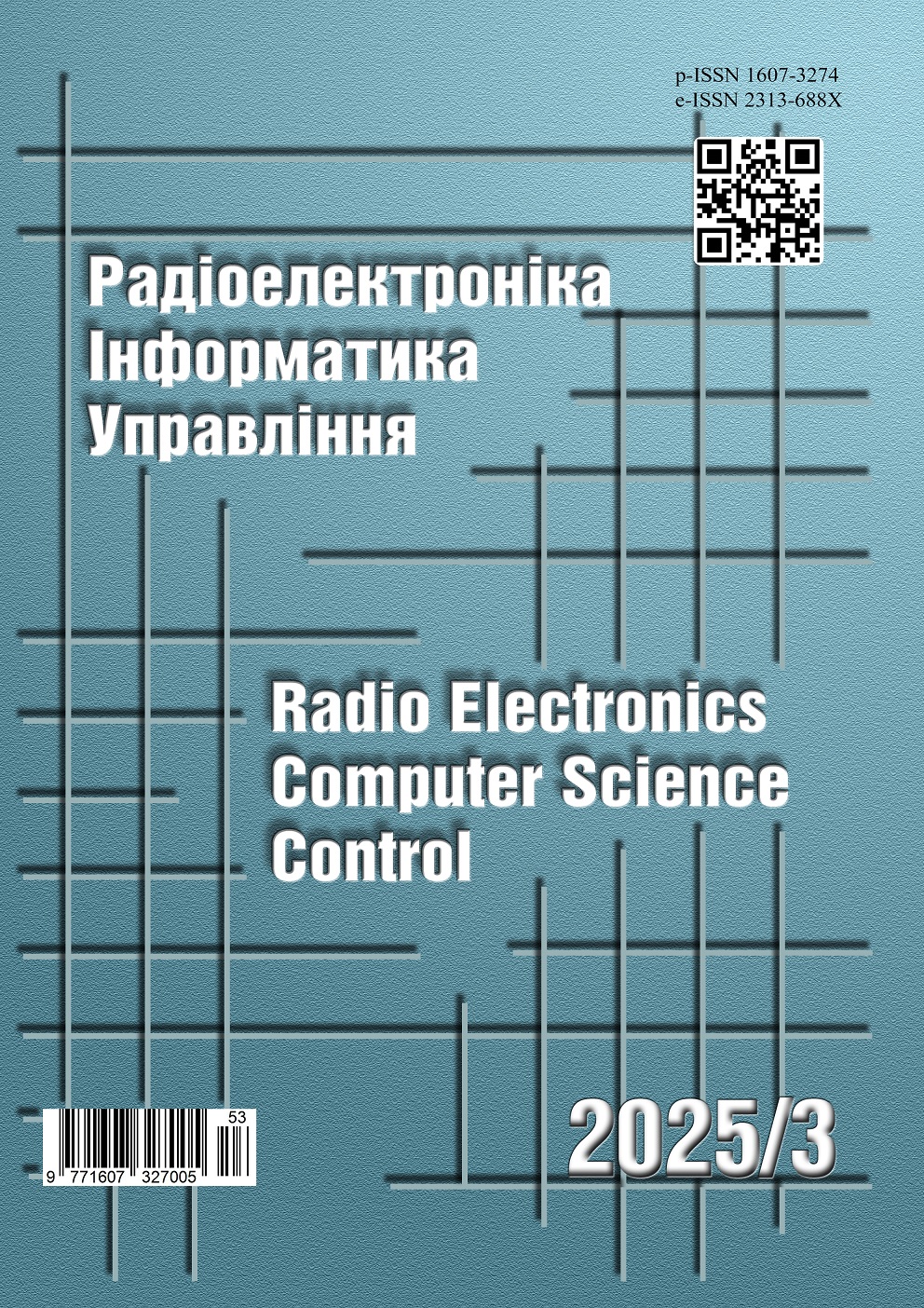REDUNDANT ROBOTIC ARM PATH PLANNING USING RECURSIVE RANDOM INTERMEDIATE STATE ALGORITHM
DOI:
https://doi.org/10.15588/1607-3274-2025-3-16Keywords:
path planning, redundant robotic manipulator, collision avoidanceAbstract
Context. Collision-free path planning in joint space for redundant robotic manipulators remains a challenging task due to the high-dimensional configuration space and dynamically changing environments. Existing methods often struggle to balance search time and path quality, which is crucial for real-time applications.
Objective. The aim of this study is to develop a new method to plan efficient, collision-free trajectories in real time for redundant robotic manipulators.
Method. A novel sampling-based algorithm for collision-free joint space path planning for redundant robotic manipulators presented in this study. The algorithm is called the Recursive Random Intermediate State (RRIS). The RRIS algorithm primarily works by generating a set of random intermediate states and iteratively selecting the optimal one based on the number of collisions along the discretized path. Furthermore, the paper proposes an axis-aligned bounding box generation strategy and an early exit strategy to improve algorithm speed. Finally, repeated calls of the algorithm are proposed to improve its reliability. The performance of the RRIS algorithm is evaluated through a set of comprehensive tests and compared with the popular RRT Connect algorithm implemented in Open Motion Planning Library.
Results. Experimental evaluations show that the RRIS algorithm under the test conditions produces collision-free paths with significantly shorter average lengths and reduces search time by approximately three times compared to the RRT Connect algorithm.
Conclusions. The proposed RRIS algorithm demonstrates a promising approach to real-time path planning for redundant robotic manipulators. By combining strategic intermediate state sampling with efficient collision evaluation and early termination mechanisms, the algorithm offers a robust alternative to known methods.
References
Data Center Solutions, IOT, and PC Innovation [Electronic resource]. Mode of access: https://www.intel.com/content/www/us/en/robotics/roboticarm.html (date of access: 15 June 2023).
Pennestri E., Cavacece M., Vita L. On the Computation of Degrees-of-Freedom: A Didactic Perspective [Electronic resource], ASME 2005 International Design Engineering Technical Conferences and Computers and Information in Engineering Conference: proceedings of the conference, [Long Beach, California, USA], September 24–28, 2005, Mode of access: https://doi.org/10.1115/DETC2005-84109, pp. 1733–1741
Ashitava G. Resolution of Redundancy in Robots and in a Human Arm, Mechanism and Machine Theory, 2018, Vol. 125, pp. 126–136.
Kavraki L. E., Svestka P., Latombe J.-C., Overmars M. H. Probabilistic Roadmaps for Path Planning in HighDimensional Configuration Spaces, IEEE Transactions on Robotics and Automation, 1996, Vol. 12, No. 4, pp. 566– 580. doi: 10.1109/70.508439.
LaValle S. M. Rapidly-Exploring Random Trees: A New Tool for Path Planning, The Annual Research Report, 1998.
Khatib O. Real-Time Obstacle Avoidance for Manipulators and Mobile Robots, The International Journal of Robotics Research, 1986, Vol. 5(1), pp. 90–98. doi:10.1177/027836498600500106.
Lillicrap T. P., Hunt J. J., Pritzel A., Heess N., Erez T., Tassa Y., Wierstra D. Continuous Control with Deep Reinforcement Learning, arXiv preprint arXiv:1509.02971, 2015.
Khan A. T., Cao X., Li Z., Li S. Evolutionary Computation Based Real-Time Robot Arm Path-Planning Using Beetle Antennae Search, EAI Endorsed Transactions on AI and Robotics, 2022, Vol. 1, P. e3.
Kuffner J. J., LaValle S. M. RRT-Connect: An Efficient Approach to Single-Query Path Planning, Proceedings 2000 ICRA. Millennium Conference. IEEE International Conference on Robotics and Automation. Symposia Proceedings (Cat. No.00CH37065). San Francisco, CA, USA, 2000, Vol. 2, pp. 995–1001, doi: 10.1109/ROBOT.2000.844730.
LaValle S. M., Kuffner J. J. Randomized Kinodynamic Planning, The International Journal of Robotics Research, 2001, Vol. 20(5), pp. 378–400. doi:10.1177/02783640122067453.
Karaman S., Frazzoli E. Sampling-Based Algorithms for Optimal Motion Planning, International Symposium on Robotics Research, 2011, May, Vol. 71, pp. 65–70.
Kang J.-G., Lim D.-W., Choi Y.-S., Jang W.-J., Jung J.-W. Improved RRT-Connect Algorithm Based on Triangular Inequality for Robot Path Planning, Sensors, 2021, Vol. 21, P. 333. https://doi.org/10.3390/s21020333.
Ganesan S., Ramalingam B., Mohan R. E. A Hybrid Sampling-Based RRT Path Planning Algorithm for Autonomous Mobile Robot Navigation, Expert Systems with Applications, 2024, Vol. 233, P. 125206. https://doi.org/10.1016/j.eswa.2024.125206.
Gammell J. D., Srinivasa S. S., Barfoot T. D. Informed RRT*: Optimal Sampling-Based Path Planning Focused via Direct Sampling of an Admissible Ellipsoidal Heuristic, arXiv preprint arXiv:1404.2334, 2014.
Bullet Collision Detection & Physics Library [Electronic resource]. Mode of access: https://pybullet.org/Bullet/BulletFull/index.html (date of access: 15 June 2023).
The Difference Between UFACTORY xArm5, UFACTORY xArm6 and UFACTORY xArm7 [Electronic resource], UFACTORY. Mode of access:
http://help.ufactory.cc/en/articles/4491842-the-differencebetween-ufactory-xarm5-ufactory-xarm6-and-ufactoryxarm7 (date of access: 15 June 2023).
Open Motion Planning Library, Version 1.4.2 [Electronic resource]. OMPL Development Team. Mode of access:
http://ompl.kavrakilab.org (date of access: 8 August 2023).
Xin P., Wang X., Liu X., Y. Wang, Z. Zhai, X. Ma Improved Bidirectional RRT* Algorithm for Robot Path Planning, Sensors, 2023, Vol. 23, No. 2, P. 1041. https://doi.org/10.3390/s23021041.
Downloads
Published
How to Cite
Issue
Section
License
Copyright (c) 2025 A. Y. Medvid, V. S. Yakovyna

This work is licensed under a Creative Commons Attribution-ShareAlike 4.0 International License.
Creative Commons Licensing Notifications in the Copyright Notices
The journal allows the authors to hold the copyright without restrictions and to retain publishing rights without restrictions.
The journal allows readers to read, download, copy, distribute, print, search, or link to the full texts of its articles.
The journal allows to reuse and remixing of its content, in accordance with a Creative Commons license СС BY -SA.
Authors who publish with this journal agree to the following terms:
-
Authors retain copyright and grant the journal right of first publication with the work simultaneously licensed under a Creative Commons Attribution License CC BY-SA that allows others to share the work with an acknowledgement of the work's authorship and initial publication in this journal.
-
Authors are able to enter into separate, additional contractual arrangements for the non-exclusive distribution of the journal's published version of the work (e.g., post it to an institutional repository or publish it in a book), with an acknowledgement of its initial publication in this journal.
-
Authors are permitted and encouraged to post their work online (e.g., in institutional repositories or on their website) prior to and during the submission process, as it can lead to productive exchanges, as well as earlier and greater citation of published work.






